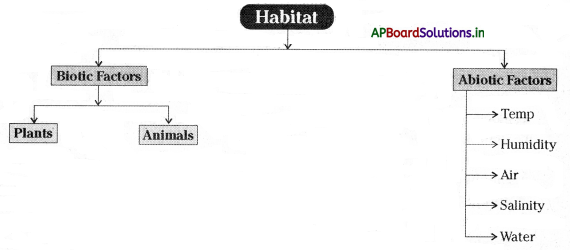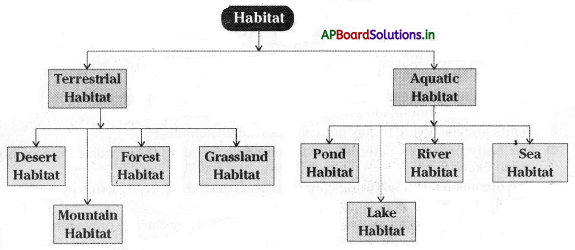Students can go through AP State Board 6th Class Science Notes Chapter 9 Organisms and Habitat to understand and remember the concept easily.
AP State Board Syllabus 6th Class Science Notes Chapter 9 Organisms and Habitat
→ There are living and non – living things around us.
→ Living things possess characteristics like growth, breathing, excretion, movement, response, and stimuli and giving birth to young ones.
→ Plants are also living things but can’t move like animals.
→ Our body produces different waste materials, sending these wastes out of the body is called excretion.
→ The organisms which lay eggs are oviparous and which give birth to young ones are called viviparous.
→ We can’t see microorganisms with our naked eyes. They can see only with a microscope.
→ The dead things are an intermediate stage between living and non-living things.
→ Seed is also a living thing but it does not have all characteristics of the living world.
→ Different organisms live in different places but many of them live in the same place.
→ The organisms usually stay in the places where most of their needs are met.
→ A habitat is a dwelling place for plants and animals that gives them optimum conditions for life.
→ Tree, pond, and house are some examples of habitat.
→ Temperature, moisture, air, water, food, shelter are the components of a habitat.
![]()
→ All the habitats may be broadly grouped into terrestrial and aquatic.
→ Habitats show the diversity of nature.
→ Birds often change habitat in search of better living conditions. For example, some birds change habitat before laying eggs.
→ We must not destroy habitats of other organisms to satisfy our needs, rather, we must try to protect them.
→ living thIngs: Things that have life
→ Non-living things: Things do not have life
→ Growth: Increasing in size
→ Breathing: Taking air into the body and sending out
→ Excretion: Removal of wastes from the body
→ Stimulus: Showing response to the reaction
→ Response: Reaction to stimulus
→ Micro-Organisms: The small organisms which cannot be seen with the naked eye
→ Microscope: An Instrument using for observing microorganisms
→ Habitat: The dwelling place of living things
→ Terrestrial habitat: Land living plants and animals
→ Aquatic habitat: Plants and animals which are living in the water
→ Orchard: Garden
→ Mangrove: Marshy soils on seashores
![]()
→ Locomotion: Movement of the body
→ Nutrition: Taking of food for health & growth
→ Adaptation: Changes in organisms to suit a new situation
→ DwellIng: LivIng place of organisms
→ Optimum: Possible options
→ Community: A group of the people


→ Live and Let Live”
Animals are partners in our habitat. They also have a right to live. We people are encroaching on their habitats. If we cut a tree, birds that live on it lose their nests and fall in danger. We often see dogs, cows, monkeys suffering from a lack of food and shelter. Some voluntary organizations work for animal rights and protection. We have to provide food and protect them. We should take it as our responsibility.
→ Cactus, Acacia, Aloe vera plants do not need much water. They are called Desert plants. We can see camels frequently in the desert. Desert plants and animals are suited to dry conditions and vast temperature differences. Different characteristics in the desert make up desert habitats.
![]()
→ Different kinds of birds come from long distances to the Kolleru and Pulicat lakes of our State. During the months of October to March, pelican birds appear on those lakes. Generally, we can see birds flying over long distances to find suitable conditions to reproduce. Animals like turtles and fish also move from place to place. Some kinds of turtles move away from the coasts of West Bengal and Odisha to the coasts of Visakhapatnam.
→ Have you heard about the Pulasa fish? Gather information about them. How and why do they change their habitat in some seasons.